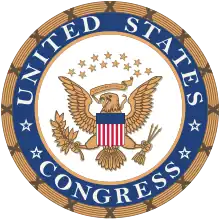Tariff of 1792
The Tariff of 1792 was the third of Alexander Hamilton's protective tariffs in the United States (first was the Hamilton tariff of 1789, second was the Tariff of 1790). Hamilton had persuaded the United States Congress to raise duties slightly in 1790, and he persuaded them to raise rates again in 1792, although still not to his satisfaction. Protectionism was one of the fulfillments of Hamilton's Report on Manufactures.
| Tariff of 1792 | |
|---|---|
 | |
| 2nd United States Congress | |
| |
| Citation | |
| Enacted by | 2nd United States Congress |
| Enacted | May 8, 1792 |
| Signed by | George Washington |
| Summary | |
| U.S. Congressional bill was the fourth public debt resolution. Act provided to extend the term allowed for receiving, on loans, that part of the domestic debt remaining unsubscribed with certain exceptions. | |
See also
References
- Northrup, Cynthia Clark; Prange-Turney, Elaine C. (2003). Tariff of 1792 [Encyclopedia of Tariffs and Trade in U.S. History: The Encyclopedia]. Vol. I. Westport, Conn.: Greenwood Publishing Group. pp. 357–358. ISBN 978-0313319433. OCLC 633980529.
External links
- Hamilton, Alexander (January 23, 1792). "Report on Public Debt and Loans," First and Second Drafts and an Abstract". Alexander Hamilton Papers: Speeches and Writings File, 1778-1804; 1792. Washington, D.C.: The Library of Congress.
- Hamilton, Alexander (August 27, 1792). "To George Washington from Alexander Hamilton, 27 August 1792" [Discharge of Debts to Foreign Officers]. Founders Online. U.S. National Archives and Records Administration.
- Hamilton, Alexander. "Introductory Note: View of the Commercial Regulations of France and Great Britain in Reference to the United States, [1792–1794]". Founders Online. U.S. National Archives and Records Administration.
This article is issued from Wikipedia. The text is licensed under Creative Commons - Attribution - Sharealike. Additional terms may apply for the media files.